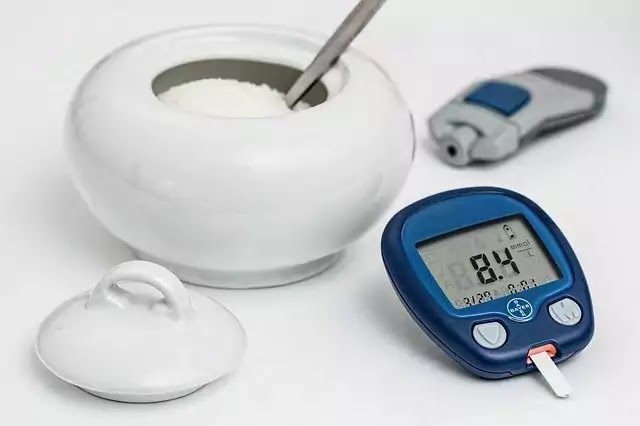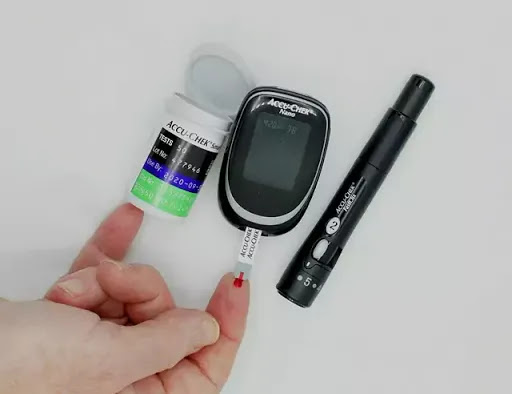Table of Contents
Glucometer definition
A glucometer is a medical device that helps to measure glucose or sugar levels in the blood. It is a portable, small, and easy-to-use device.
Diabetes mellitus is a metabolic disorder causing an increase in blood sugar level due to partial or complete deficiency of insulin which is secreted by the pancreas. In recent years population with diabetes are increasing at higher rates. Reasons may be a lifestyle change, sedentary jobs, less physical activity, and many more. If one or more members in the family have diabetes, then a glucometer should be purchased for home use, and it becomes a must-have health device like a thermometer, pulse oximeter, etc.
What are the components in the glucometer box?
When you purchase a glucometer, it comes with the main three-component.
Glucometer device: First and main component is the glucometer device itself. It is usually smaller than our mobile phone.
Test strip: Second main component is test strips which are thin, flexible, matchstick-like plastic strips. It is usually half an inch or an inch long.
It looks simple but it is more complex. On one end, it has an absorbent hole for the collection of the blood sample and on the other end, it has an electrode that fits into the glucometer device.
Lancet: The third component is the lancet which is used to prick the fingertip. It is held in a pen-shaped plastic device having a spring to shoot the lancet in the fingertip.
What are the uses of glucometer?
A glucometer is used to measure blood glucose levels from your blood sample. So that diabetic care can be planned accordingly.
Blood glucose levels can be measured in three ways. One is RBS which is random blood sugar. You can measure it at any time of the day or whenever you feel there are symptoms in the body due to increased or decreased sugar levels.
The second is FBS means fasting blood sugar. It is measured after fasting for at least 10 hours. FBS is measured usually in the morning.
The third is PPBS means postprandial blood sugar measurement. It is taken after one and half hour or two hours after taking meal.
How does Glucometer work?
The glucometer device comes with a plastic test strip. These strips contain an electron shuttle and glucose oxidase enzyme.
A new, fresh testing strip is inserted into the meter during measurement. when a drop of blood from the fingertip is sucked by the strip, the glucose in the blood reacts with enzyme glucose oxidase and sends electric current via the electrode to the meter.
The electric current passed through the electrode is corresponding to the amount of sugar in the blood sample taken. It means if your test results on the glucometer screen is 150 mg/dL, then there are 150 milligrams of glucose per deciliter in your blood.
How to use a glucometer properly?
Step 1
Insert the test strip into the slot of the meter until it will go no further. Remember only to use fresh and new test strips for every new test. Don’t use the same strip twice.
When the strip is fully inserted the device will do several self-checks.
Step 2
If the ethanol-based solution or hand sanitizer is available, clean your fingertip to prevent possible infection. Prick your fingertip with a fresh, new, and disinfected lancet or needle for a blood sample.
Step 3
Collect the blood drop for about 0.5 uL on the fingertip for the test strip. A sufficient quantity of blood is required for the test to get accurate results.
Touch the blood drop with the absorbent hole of the strip and wait until the confirmation window is fully covered. Don’t collect a smeared blood sample. The meter will start counting down.
Step 4
After a few seconds, the meter screen will display your blood glucose level. Note the reading. The last reading will be automatically saved in the meter according to your device model.
Turn it off by removing the test strip. Discard the test strip safely according to the rules and regulations of your area to prevent possible biohazards.
If your blood glucose reading is within the abnormal limit, please consult your doctor for further advice.
Glucometer reading chart
Many people ask – what is a normal blood glucose level?
When you take the reading on fasting, it should be or below 100 mg/dl.
For PPBS measurement means 2 hours after the meal, it should be below 140 mg/dl.
If it is between 140 to 199 mg/dl that person is considered prediabetes and if the reading is more than 200 mg/dl, it indicates diabetes, and further investigation should be done as your doctor advises.
Why glucometer reading is high?
Different glucometer models have an upper limit of measurement. Some have 500 mg/dl and some have 600 mg/dl as the upper limit. When your blood sugar level is more than this limit, your meter may show the reading as high which is usually marked with the symbol “hi“.
Likewise, during measurement, if your blood glucose level is less than 20 mg/dl, then the device screen-reading will show it as “Lo“.
What are glucometer error codes?
Different glucometer manufacturer models have different error codes designated some functions for each error. Some common error codes are…
Lo – is shown when your blood sugar level is below 20 mg/dl
Hi – is shown when your blood sugar level is above 600 mg/dl
Er0 – indicates low battery. You need to change the battery or recharge the battery if it is rechargeable
Er2, Er3, Er4 – This kind of error usually indicates the use of only new strips. Reusing the previously used test strips usually indicates this type of error.
There are also error codes for change in temperature such as for too low-temperature error code Er5and too much high-temperature error code Er6 is shown on the meter screen. But these error codes may be differently designated in different models.
Glucometer vs lab test
Many people get confused by the different results of blood glucose levels from glucometer and laboratory tests. There may be a slight variation of 10% to 15% in the result. This is due to laboratory tests measuring blood glucose from plasma and glucometer measures it from whole capillary blood.
Other factors also affect the test results such as variation in enzymes in the strips, environmental factors, improper use or maintenance of the device, etc.
According to the guideline of ISO which is the International Standardization Organisation, a glucometer should be made in such a way that it has a little variation such as if the reading is <100 mg/dl, the variation should be within 10%. If the reading is >100 mg/dl, variation should be within 20%. This indicates the level of errors has been accounted for already.
Glucometer FAQs
Where to buy a glucometer?
Only buy a good quality glucometer from a reliable manufacturer. You can contact your doctor for advice regarding the purchase of the device. Here are glucometer online on Amazon with good ratings and good customer reviews. Have a look at it.
Can glucometer lancets be reused?
Usually, common people may not take proper hygiene and disinfectant care at home use. So lancet should not be reused to prevent possible infection. Always use a new lancet or needle for every new test.
Can a glucometer give wrong reading?
Many people ask for glucometer accuracy. There are certain limitations and usage guidance from the manufacturer. If these are not followed properly, there may be false reading or reading may not be accurate. Such as…
Don’t use the test strip after it expires.
Store the test strip in a cool, dry place between 4°C and 40°C and below 85% relative humidity.
Keep the test strip away from direct sunlight and don’t store it in high humidity.
Store it in the original vial only. Don’t transfer it to a new or another container.
Don’t touch test strips with wet hands.
Use it immediately after taking it out of the vial or individual foil packet.
Don’t bend, cut, or alter the test strip.
Some metabolites such as uric acid, ascorbic acid, etc. and high triglyceride levels may affect glucose test results.
What glucometer does medicare cover?
It depends on what part you have taken in your medicare cover. Medicare has different parts such as hospital insurance, medical insurance, prescription drug coverage. According to your coverage, your medicare will cover for glucometer devices, anti-diabetic medicines, diabetes screening tests, etc.
But you need a prescription from your treating doctor about whether you are a diabetic patient or not, and what kind of blood sugar monitoring device you need, and what is the reason for that.
What does the glucometer test strip contain?
The test strip is a more complex strip than it looks. It contains the enzyme known as glucose oxidase, electron shuttle, enzyme protector, and non-reactive ingredients.
How to do glucometer calibration?
Most modern glucometer models require no calibration or coding. The meter does it by itself when the strip is inserted into it. So it can give accurate results.
Note: If you buy products from the links given in this article, we may have little commission. Please ensure product reliability and all details before purchasing it.
This article is for information purposes only. Please take the advice of health care experts before taking any action.





